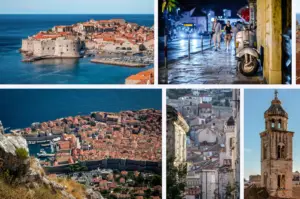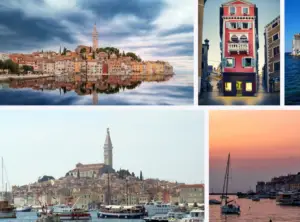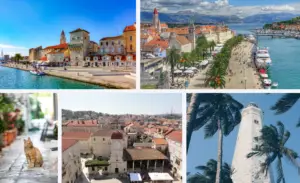10 Most Beautiful Cities To Visit In Croatia | Most Beautiful Cities In Croatia

- By
- Aparna Patel
- |
- 17 Apr, 2023
- |

Welcome to our travel blog where we explore the stunning country of Croatia and highlight its most beautiful cities to visit. Croatia is a country that has become increasingly popular among travelers in recent years, and for good reason. Its stunning coastline, crystal-clear waters, and rich history and culture make it a must-visit destination for any avid traveler.
In this blog, we will take you on a journey to some of the most beautiful cities in Croatia, each with its unique charm and beauty. From the vibrant city of Dubrovnik to the picturesque town of Rovinj, we will show you why Croatia is truly a gem of the Mediterranean. So, sit back, relax, and let us take you on a tour of the most beautiful cities to visit in Croatia.
Croatia is a beautiful country on the Adriatic Sea, known for its stunning beaches, historic cities, and rich cultural heritage. Here are the top 10 most beautiful cities to visit in Croatia:
These cities offer a range of activities and attractions, from exploring ancient history to relaxing on beautiful beaches. Whether you’re interested in culture, nature, or simply soaking up the local atmosphere, there’s something for everyone in these beautiful Croatian cities.
Table of Contents
1.Dubrovnik
Dubrovnik is a city located on the Adriatic coast in southern Croatia. It is known for its beautiful architecture, historic city walls, and stunning views of the sea. Dubrovnik is often called the “Pearl of the Adriatic” and is a popular tourist destination.
Travel Information:
- Getting there: The closest airport to Dubrovnik is Dubrovnik Airport, which is located about 20 kilometers from the city center. You can also reach Dubrovnik by bus or ferry from other cities in Croatia and neighboring countries.
- Getting around: The old town of Dubrovnik is pedestrian-only, so walking is the best way to get around this area. For exploring the surrounding areas, you can take a bus or hire a car.
- Accommodation: Dubrovnik has a range of accommodation options, from luxury hotels to budget hostels. If you want to stay in the historic old town, be prepared to pay a premium.
- Currency: Croatia uses the Croatian Kuna (HRK) as its currency. Many shops and restaurants also accept euros, but it’s always best to have some kuna on hand.
- Language: The official language of Croatia is Croatian, but many people in Dubrovnik speak English.
- Weather: The best time to visit Dubrovnik is during the shoulder seasons of spring and fall when the weather is mild and the crowds are smaller. Summers can be hot and crowded, while winters are cool and rainy.
- Attractions: Some of the top attractions in Dubrovnik include the city walls, the Stradun (the main street of the old town), the Rector’s Palace, and the Dubrovnik Cathedral. You can also take a cable car up to Mount Srd for stunning views of the city and the Adriatic Sea.
- Food: Dubrovnik is known for its seafood and Mediterranean cuisine. Some local specialties to try include black risotto (made with squid ink), octopus salad, and grilled fish. There are also many cafes and bakeries where you can sample traditional Croatian sweets like fritule (doughnut-like pastries) and kroštule (fried dough twisted into knots).
2.Split
Split, which is the second-largest city in Croatia and the largest city in the region of Dalmatia. Split is known for its ancient Roman history, stunning coastline, and vibrant cultural scene. Some of the top attractions in Split include the Diocletian’s Palace, which is a UNESCO World Heritage site, the Cathedral of Saint Domnius, and the Riva waterfront promenade.
As for travel information, here are some useful tips for visiting Split:
- Best time to visit: The best time to visit Split is between April and September when the weather is warm and sunny. July and August are the busiest months, so if you prefer a more relaxed atmosphere, you might want to consider visiting in May, June, or September.
- Getting around: Split is a walkable city, and most of the top attractions are within easy walking distance of each other. However, if you want to explore further afield, there are buses, taxis, and ferries available.
- Accommodation: Split has a wide range of accommodation options, from budget-friendly hostels to luxury hotels. If you want to stay in the heart of the old town, look for accommodation near the Diocletian’s Palace.
- Food and drink: Split is known for its delicious seafood and Mediterranean cuisine. Some popular dishes to try include black risotto, grilled fish, and pasticada (a beef stew). To wash it down, try some local wines or rakija (a fruit brandy).
- Safety: Split is generally a safe city, but like any tourist destination, you should be aware of your surroundings and take precautions to protect your belongings.
3.Rovinj
Rovinj is a city located on the western coast of the Istrian peninsula in Croatia. It’s known for its stunning architecture, beautiful beaches, and charming old town. Some of the top attractions in Rovinj include the Church of St. Euphemia, the Balbi Arch, and the Rovinj Aquarium.
Here are some travel tips for visiting Rovinj:
- Best time to visit: The best time to visit Rovinj is between May and September when the weather is warm and sunny. July and August are the busiest months, so if you prefer a more relaxed atmosphere, you might want to consider visiting in May, June, or September.
- Getting around: Rovinj is a small city, and most of the top attractions are within easy walking distance of each other. However, if you want to explore further afield, there are buses and taxis available.
- Accommodation: Rovinj has a wide range of accommodation options, from budget-friendly hostels to luxury hotels. If you want to stay in the heart of the old town, look for accommodation near the Church of St. Euphemia.
- Food and drink: Rovinj is known for its seafood and Istrian cuisine. Some popular dishes to try include black risotto, grilled fish, and truffle pasta. To wash it down, try some local wines or rakija (a fruit brandy).
- Safety: Rovinj is generally a safe city, but like any tourist destination, you should be aware of your surroundings and take precautions to protect your belongings.
4.Pula
Pula is a city located in the southern part of the Istrian peninsula, in Croatia. It is the largest city in Istria County, with a population of approximately 57,000 people. Pula is known for its rich history, beautiful beaches, and cultural attractions.
One of the main attractions in Pula is the well-preserved Roman amphitheater, known as the Arena. This 2,000-year-old structure is one of the largest and most well-preserved Roman amphitheaters in the world, and is still used today for various events and performances.
Other notable attractions in Pula include the Temple of Augustus, the Arch of the Sergii, the Forum, and the Archaeological Museum of Istria. The city also has a number of beautiful beaches, including Verudela Beach and Banjole Beach, which are popular among tourists.
In terms of transportation, Pula has its own airport, which is located approximately 6 km from the city center. The city is also well-connected by bus and train to other parts of Croatia and Europe. Within the city, there are buses that run regularly to different parts of Pula and the surrounding areas.
Pula has a Mediterranean climate, with mild winters and hot summers. The best time to visit is during the summer months, when the weather is warm and there are a number of outdoor events and festivals.
Overall, Pula is a beautiful city with a rich history and plenty of attractions for visitors to enjoy. Whether you’re interested in ancient history, beaches, or cultural events, Pula has something for everyone.
5.Trogir
Trogir is a small city located on the central Dalmatian coast in Croatia, about 25 km west of Split. It is a UNESCO World Heritage site, known for its well-preserved medieval architecture and beautiful beaches.
The heart of the city is the old town, which is situated on a small island connected to the mainland by a bridge. The old town is home to a number of historic sites, including the Cathedral of St. Lawrence, the Kamerlengo Fortress, and the Town Hall.
One of the most notable attractions in Trogir is the St. Lawrence Cathedral, a Romanesque-Gothic church that dates back to the 13th century. The cathedral features an impressive bell tower and beautiful carved doors, and is home to a number of works of art.
Trogir also has a number of beautiful beaches, including Okrug Beach, which is one of the most popular. The beach is located on the nearby island of Čiovo and is easily accessible from Trogir by car or bus.
Trogir is easily accessible by bus or car from nearby cities such as Split and Šibenik. The city also has its own airport, located about 5 km from the city center. Within the city, it is easy to get around on foot, as the old town is relatively small and pedestrian-friendly.
Overall, Trogir is a charming and picturesque city with a rich history and plenty of attractions for visitors to enjoy. Whether you’re interested in history, architecture, or beaches, Trogir has something for everyone.
6. Zagreb
Zagreb is the capital and largest city of Croatia, located in the northwestern part of the country. It is a vibrant and dynamic city with a rich history, beautiful architecture, and plenty of cultural attractions.
The city is divided into two parts: the Upper Town (Gornji grad) and the Lower Town (Donji grad). The Upper Town is the historic heart of Zagreb, with narrow streets, old churches, and charming squares. The Lower Town is more modern and commercial, with wide boulevards, shops, and restaurants.
Places to Visit: The Zagreb Cathedral, a beautiful Gothic-style cathedral that dates back to the 13th century. Other notable attractions in the city include the St. Mark’s Church, the Croatian National Theatre, and the Museum of Broken Relationships.
Zagreb also has a number of parks and green spaces, including Maksimir Park, which is one of the oldest public parks in Europe. The park features a large lake, forests, and a zoo.
Zagreb has its own airport, located about 17 km from the city center. The city is also well-connected by train and bus to other parts of Croatia and Europe. Within the city, there is a good public transportation system, including trams and buses.
Zagreb has a continental climate, with cold winters and hot summers. The best time to visit is during the spring and autumn months, when the weather is mild and there are fewer tourists. However, the city is also beautiful during the winter months, when it is decorated for the holidays and there are outdoor markets and festivals.
Overall, Zagreb is a beautiful and vibrant city with a rich history and plenty of attractions for visitors to enjoy. Whether you’re interested in history, culture, or outdoor activities, Zagreb has something for everyone.
7.Hvar
Hvar is a small city located on the island of the same name, in the Adriatic Sea off the coast of Croatia. It is known for its stunning natural beauty, rich history, and vibrant nightlife.
The city is situated on the southern coast of the island and is surrounded by crystal-clear waters and rugged coastline. One of the main attractions in Hvar is the old town, which is a maze of narrow streets and charming squares. The old town is home to a number of historic buildings, including the 16th-century Hvar Cathedral and the 17th-century Arsenal.
Another popular attraction in Hvar is the Pakleni Islands, a group of 16 small islands that are located just off the coast. The islands are known for their pristine beaches and crystal-clear waters, and are a popular spot for swimming, snorkeling, and sunbathing.
In terms of transportation, Hvar is accessible by ferry from Split or Dubrovnik, and there are also regular ferry services to other nearby islands. Within the city, it is easy to get around on foot, as the old town is relatively small and pedestrian-friendly.
Overall, Hvar is a beautiful and charming city with a rich history and plenty of attractions for visitors to enjoy. Whether you’re interested in beaches, history, or nightlife, Hvar has something for everyone.
8.Korcula
Korcula is a small city located on the island of the same name, in the Adriatic Sea off the coast of Croatia. It is known for its beautiful architecture, rich history, and stunning natural beauty.
The city is situated on the northeastern coast of the island and is surrounded by crystal-clear waters and picturesque countryside. One of the main attractions in Korcula is the old town, which is a maze of narrow streets and charming squares. The old town is home to a number of historic buildings, including the 15th-century St. Mark’s Cathedral and the Marco Polo House.
Another popular attraction in Korcula is the nearby beaches, which are known for their crystal-clear waters and white sandy beaches. Some of the most popular beaches in the area include Vela Przina, Pupnatska Luka, and Lumbarda.
In terms of transportation, Korcula is accessible by ferry from Split, Dubrovnik, or other nearby islands. Within the city, it is easy to get around on foot, as the old town is relatively small and pedestrian-friendly.
Overall, Korcula is a beautiful and charming city with a rich history and plenty of attractions for visitors to enjoy. Whether you’re interested in beaches, history, or natural beauty, Korcula has something for everyone.
9.Sibenik
Šibenik is a small city located on the central coast of Croatia, in the region of Dalmatia. It is known for its beautiful historic center, stunning natural beauty, and rich cultural heritage.
The city is situated on the banks of the Krka River, near the Krka National Park. One of the main attractions in Šibenik is the St. James Cathedral, a UNESCO World Heritage site that was built in the 15th century. Other notable attractions in the city include the St. Michael’s Fortress, the Museum of Šibenik, and the Four Wells Square.
Krka National Park, which is known for its waterfalls, lakes, and lush vegetation. Visitors can hike along the trails, swim in the lakes, and take boat tours to see the waterfalls up close.
Šibenik is accessible by bus or car from Split or Zadar, and there is a small airport nearby. Within the city, it is easy to get around on foot, as the historic center is relatively small and pedestrian-friendly.
Overall, Šibenik is a beautiful and charming city with a rich history and plenty of attractions for visitors to enjoy. Whether you’re interested in history, culture, or natural beauty, Šibenik has something for everyone.
10.Zadar
Zadar is a charming city located on the Dalmatian Coast and is known for its beautiful beaches, ancient ruins, and vibrant nightlife. Visitors can explore the city’s many historical landmarks, sample delicious local cuisine, or take a dip in the crystal-clear waters of the nearby beaches. 
Some travel information to help you plan your trip to Zadar:
- Getting There – Zadar has its own airport, which is located about 8 kilometers from the city center. You can also reach Zadar by bus, train or car from other major cities in Croatia.
- Accommodation – Zadar has a range of accommodation options to suit all budgets, including hotels, hostels, and apartments. It’s best to book your accommodation in advance, especially during peak travel season.
- Weather – Zadar has a Mediterranean climate, with hot summers and mild winters. The best time to visit Zadar is during the summer months (June-August) when temperatures are warm and the weather is perfect for outdoor activities.
- Things to Do – Zadar is a city rich in history and culture, with plenty of things to see and do. Some of the must-see attractions in Zadar include the ancient Roman Forum, the Church of St. Donatus, and the Sea Organ, an architectural marvel that creates music from the waves of the sea.
- Food and Drink – Zadar is known for its delicious seafood, traditional Croatian dishes, and local wine. Some of the must-try dishes in Zadar include black risotto, octopus salad, and peka, a traditional Croatian dish that is slow-cooked under a metal dome.
- Getting Around – Zadar is a walkable city, and most of the major attractions are located within walking distance of each other. However, if you prefer not to walk, there are also buses, taxis, and bicycles available for rent.
Zadar is a beautiful city that offers something for everyone, from history and culture to outdoor activities and delicious cuisine. With its stunning coastline and rich history, Zadar is truly a must-visit destination for any traveler.
Related Articles
- 10 Most Beautiful Cities To Visit In Norway
- 10 Most Beautiful Cities To Visit In Greece
- 10 Most Beautiful Cities To Visit In Sweden
These are just a few of the many beautiful cities to visit in Croatia. With its stunning coastline, rich history, and vibrant culture, Croatia is truly a must-visit destination for any avid traveler.
Search Posts
Latest posts
-
5 Mar, 2024
Why prohibit engine braking?
Popular posts
-
5 Mar, 2024
Why prohibit engine braking?
-
5 Mar, 2024
How to avoid drinking vodka?